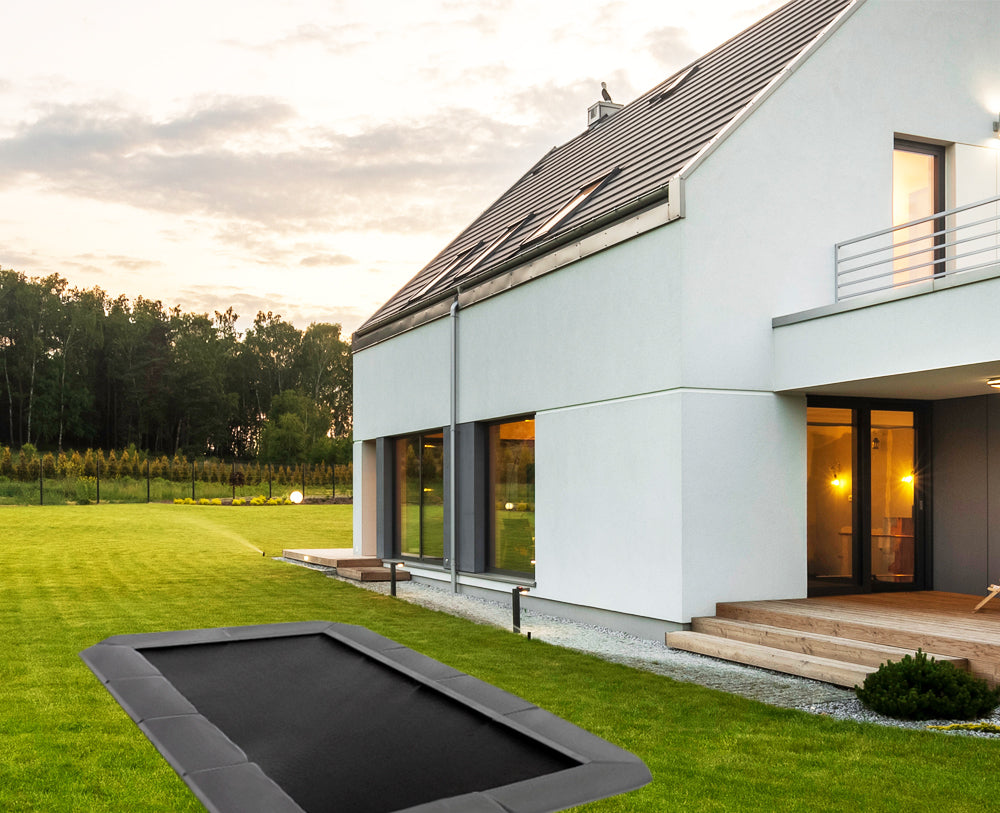Sunken trampolines pose both aesthetic and safety benefits, yet they are not without their issues. Installation challenges and water accumulation rank among the top concerns.
Exploring the world of in-ground sunken trampolines can be both exciting and daunting. These trampolines blend seamlessly into the landscape, offering a less obtrusive play option compared to their above-ground counterparts. They draw families looking for a safer trampoline experience, as there is less risk of falling from a significant height.
Despite the allure, potential owners must navigate a series of considerations before taking the plunge. Sunken trampolines require a substantial initial investment to install, including excavation and additional accessories for proper operation. Maintenance becomes a priority due to the propensity for debris collection and potential drainage issues. Understanding the full spectrum of what owning a sunken trampoline entails ensures that enthusiasts make informed decisions for their leisure and their landscape.
Sunken Trampolines: A Backyard Revolution
Sunken Trampolines: A Backyard Revolution marks a fresh take on outdoor amusement. Homeowners everywhere are embracing the blend of safety and aesthetics offered by in-ground trampolines. With the craze catching on quickly, let’s delve into what makes these trampolines a hot property in home backyards.
Rising Popularity Of In-ground Trampolines
The allure of in-ground trampolines is evident. Low profiles meld with landscapes, drawing families to recreate in their own yards. They are safer to access, and with no height to fall from, the injury risk diminishes. Parents enjoy peace of mind, while kids leap and laugh close to the ground.
- Seamless garden integration
- Enhanced safety features
- Appealing to all age groups
Key Features Of Sunken Trampolines
Key features set sunken trampolines apart. They offer aesthetic synergy and a concealed bounce area that doesn’t obstruct views. Drainage systems prevent water accumulation. Sustainable materials often used in construction support eco-friendly choices.
| Feature | Benefit |
|---|---|
| Underground Placement | Reduces visual clutter |
| Easy Access | Increases safety for users |
| Custom Drainage Solutions | Prevents standing water |
| Eco-friendly Materials | Promotes environmental care |

Credit: www.amazon.com
Aesthetic Integration Into Landscaping
Aesthetic Integration into Landscaping elevates the charm of outdoor spaces. Sunken trampolines blend seamlessly with garden designs. They offer a thrilling play area without disrupting nature’s beauty. Below, explore how these in-ground features can enhance or challenge your garden’s look.
Visual Benefits In Garden Design
Integrating a sunken trampoline into your garden carries distinct visual advantages:
- Invisible edge: The trampoline’s border hugs the ground, making it nearly invisible.
- Continuity: Lawns and flower beds continue unbroken, creating a fluid look.
- Space illusion: Sunken trampolines make small yards appear larger.
These elements maintain your garden’s natural aesthetic while adding fun functionality.
Challenges Of Blending With Natural Elements
However, integrating a sunken trampoline with landscaping comes with challenges:
- Drainage: Ensuring proper drainage around the trampoline prevents water pooling.
- Plant roots: Nearby roots could disrupt the structure over time.
- Material choice: Selecting the right edging materials is key to a natural look.
Addressing these issues early in the design phase helps for a smoother installation.
Safety Concerns And Advantages
Exploring in-ground sunken trampolines uncovers a multitude of safety benefits alongside a few concerns. These innovative outdoor features blend seamlessly with the lawn, providing an exciting twist to traditional bouncing fun.
Reduced Fall Height And Potential Injuries
One of the standout pros of in-ground sunken trampolines is the decreased risk of high falls. Ground level entry minimizes injury risks, making them a safer choice, especially for youngsters. Kids can jump with joy, knowing the ground is just inches away.
- Lower impact falls: Less space to tumble reduces chances of severe harm.
- Unobtrusive design: Melds with your yard, keeping the aesthetic appeal intact.
- Accessibility: Easy for all ages to climb on and off.
Remaining Safety Risks To Consider
While in-ground trampolines offer improved safety, certain risks linger. It’s crucial to stay vigilant.
| Risk Factor | Preventive Measures |
|---|---|
| Equipment Deterioration | Regular checks and maintenance are essential. |
| Pooling Water | Ensure adequate drainage to prevent moisture damage. |
| Debris Accumulation | Keep the area clear to avoid accidents. |
Protective netting and padding remain imperative for an added security layer. It is paramount to consider these elements for holistic safety measures.

Credit: www.reddit.com
Installation Complexities And Cost Implications
Deciding to install an in-ground sunken trampoline turns your backyard into an adventure park. But the journey from decision to first jump involves hurdles and a wallet-check.
In-ground Installation Procedures
Installing an in-ground sunken trampoline is not a simple task. Here’s what the process generally involves:
- Planning: Identifying the perfect spot and checking for utility lines.
- Excavation: Digging a hole that matches the trampoline size and shape.
- Support: Installing retaining walls to prevent soil-collapse.
- Drainage: Ensuring water doesn’t collect underneath and cause damage.
- Installation: Fitting the trampoline frame neatly into the ground.
Each step requires precision and safety precautions. Errors can cause injury or damage.
Financial Considerations Of Sunken Trampolines
The cost of installing a sunken trampoline is more than just the unit’s price. Here are financial aspects to consider:
- Purchase cost: Price of the trampoline itself.
- Installation fees: Payment for professional installers.
- Excavation costs: Hiring diggers or equipment.
- Retaining walls and drainage systems: Vital for long-term stability.
- Maintenance expenses: Ongoing costs for upkeep.
Families should create a comprehensive budget to include these expenses.
Durability And Maintenance Issues
When choosing a sunken trampoline, think about how long it will last and what it takes to keep it in good shape. Unlike their above-ground cousins, in-ground models face different challenges. In this deep dive, we’ll explore the key concerns related to the durability and maintenance of sunken trampolines.
Longevity Comparison To Above-ground Models
In-ground trampolines often promise a sleek look, blending with the yard. But do they last as long as above-ground ones? A closer look tells the story. Sunken trampolines are exposed to moisture and soil conditions, which can affect their metal parts. Regular checks are vital to prevent rust and decay. On the flip side, they’re sheltered from strong winds and are not as likely to tip over during bad weather.
| Trampoline Type | Pros | Cons |
|---|---|---|
| In-Ground |
|
|
| Above-Ground |
|
|
Regular Maintenance And Upkeep Costs
Maintenance is a key part of keeping a sunken trampoline safe. Regular cleanups and checks make sure the bounce stays consistent. Avoiding water buildup is crucial. A good drainage system is a must to prevent rust and mold. Above-ground trampolines also need maintenance but they have better airflow which helps keep them dry. Remember, improper care leads to more repairs and higher long-term costs.
- Examine frame and springs for early signs of wear or damage.
- Keep the jumping mat clean and free from garden debris.
- Ensure proper drainage to combat moisture related problems.
Here’s a breakdown of expected costs:
- Drainage system: Important for moisture control, may require professional installation.
- Rust-proofing treatments: Helps extend the life span of the trampoline.
- Replacement parts: Springs and mats may need replacing due to wear or damage.
Drainage Problems And Solutions
In-ground trampolines are a seamless addition to any backyard, offering hours of fun without obstructing the view. Yet, one often-overlooked aspect is how they deal with water. Proper drainage is critical to maintain a safe and functional trampolining space. Ignoring this can lead to various problems, but, luckily, there are solutions that ensure your sunken trampoline remains problem-free.
Water Accumulation Risks
Water pooling beneath a trampoline can be a nuisance, leading to several risks:
- Rust and corrosion of the trampoline frame and springs.
- Mosquito breeding grounds, as stagnant water attracts pests.
- Increased risk of injury due to slippery surfaces.
- Ground sinking or erosion, which can affect stability.
Effective Drainage Systems For In-ground Trampolines
Implementing effective drainage is a proactive way to prevent water-related issues:
- French Drains: A popular method involving a trench filled with gravel or rock that redirects water away from the trampoline pit.
- Drainage Channels: These are installed around the trampoline edge to collect and guide water to a safe discharge area.
- Dry Wells: A storage solution that allows water to slowly infiltrate into the ground, reducing the risk of water pooling.
- Pump Systems: Ideal for areas with significant rainfall, electric pumps actively remove water from the trampoline pit.
Each system has its own set of pros and cons, such as the sustainability of dry wells versus the immediate impact of electric pumps. Consideration for local climate, soil type, and your usage patterns will guide the best choice for your trampoline’s longevity and safety.
Impact On Home Value And Insurance
Are you considering adding a sunken trampoline to your backyard? An in-ground trampoline can not only provide endless fun for the family but also have an interesting effect on your home’s market appeal and obligations you need to consider. Weighing the pros and cons of this addition in terms of property value and insurance can help you make an informed decision.
Potential Increase In Property Value
A sunken trampoline can be a delightful feature for potential home buyers. It merges seamlessly with the landscaping. Families might love the idea of a built-in play area for kids. This addition could potentially increase your property’s attractiveness and value. Here are a few points to consider:
- Aesthetic appeal with a cohesive yard design
- Appealing to families looking for kid-friendly homes
- May increase interest in your property when selling
Insurance Considerations And Liabilities
With any property addition, you should think about insurance implications. A sunken trampoline is no exception. You need to understand how it affects liability. Contact your insurance provider to ensure appropriate coverage. Here’s what you need to consider:
| Insurance Aspect | Details to Consider |
|---|---|
| Potential Premium Increase | Trampolines can increase the risk of injury and potentially lead to higher insurance premiums. |
| Disclosure Requirement | Failure to inform your insurer about the trampoline could result in denied claims. |
| Safety Regulations | Your insurer may have specific safety requirements for trampolines to maintain coverage. |
Understanding the pros and cons of a sunken trampoline can determine if it is the right addition to your home. The potential to increase your property value might be appealing, but balancing it with the right insurance coverage is crucial for peace of mind.
The Debate Over Bounce Quality
Choosing a sunken trampoline often sparks a lively discussion about bounce quality. Traditional trampolines stand above ground and offer a certain kind of performance. But can an in-ground design match this? People with varied experiences add to the debate, citing differences in bounce and performance. Let’s dive into how these in-ground models compare, touching on performance and bounce dynamics.
Performance Differences From Traditional Trampolines
- Air circulation: In-ground trampolines might have restricted airflow, which can impact the bounce.
- Frame flexibility: Traditional frames can slightly move, offering a dynamic bounce. Sunken trampolines are often more rigid.
- Spring design: The type and length of springs used can vary, changing the overall bounce.
Each of these aspects contributes to the performance of a trampoline. Understanding these can help in making an informed choice.
Factors Affecting Bounce Dynamics
| Factor | Effect on Bounce |
|---|---|
| Spring Quality | Higher quality springs usually equate to a better bounce. |
| Mat Material | A material that stretches well enhances the bounce experience. |
| Hole Depth | Deeper holes might reduce airflow, affecting bounce. |
| Pit Construction | Poor construction can lead to uneven bouncing surfaces. |
These factors can vary between trampoline types. For the best bounce, consider the design and construction of the sunken trampoline in detail.
The Verdict: Weighing The Pros And Cons
Choosing the right trampoline is crucial for fun and safety. Sunken trampolines are popular. Let’s weigh their pros and cons to see if they’re right for you.
Summarizing The Advantages Of Sunken Trampolines
- Safer jumps: Being at ground level, the fall risk reduces.
- Better aesthetics: They blend into your garden design.
- No need for ladders: Easy to get on and off.
- Wind resistance: Lower profile, fewer wind-related issues.
Acknowledging The Drawbacks And Making An Informed Decision
- Installation can be costly and complicated.
- Potential for higher maintenance needs due to debris.
- Drainage issues could cause a mucky mess.
- Limited relocation options after installation.
| Pros | Cons |
|---|---|
| Safer for children | Installation costs |
| Seamless landscape integration | Complex maintenance |
| Easy access | Drainage concerns |
| Less wind impact | Hard to move once installed |
Decide based on these points. Think about your space and usage. Pick the best match for your family joy.
Future Innovations And Trends In Trampoline Design
As we leap into the future, trampoline design is bouncing ahead with impressive innovations. These changes aim to address common issues with sunken trampolines while enhancing the fun and safety of these popular backyard features. Let’s dive into the trends shaping the next wave of trampoline enjoyment.
Advancements In Safety And Durability
Safety remains the paramount concern with trampolines. Emerging designs focus on minimizing injury risks for users of all ages. Manufacturers are developing new materials and construction techniques to cope with environmental stressors such as UV rays and moisture.
- Enhanced padding offers better protection against impacts.
- Robust springs and frames promise longer life spans and sustained bounce quality.
- Springless models reduce injury risk posed by exposed springs.
- Smart trampolines equipped with sensors to alert users about unsafe conditions or improper use.
Emerging Trends In Recreational Equipment
Recreation evolves hand in hand with technology. Trampoline design is set for a playful revolution, integrating interactivity and personalization to attract users of a digital era.
- Interactive game integration where LED lights and sensors create immersive experiences.
- Customizable themes with interchangeable mats and pads to reflect personal styles or change with seasons.
- App connectivity for fitness tracking and integration with smart home systems.
- Modular designs allowing for expansion or reconfiguration, adapting to space and user needs over time.

Credit: www.trampolinesinground.com
Frequently Asked Questions On 10 In-ground Sunken Trampoline Problems With Pros & Cons
Are In-ground Trampolines Safer Than Above-ground?
In-ground trampolines typically offer enhanced safety due to their lower profile, reducing the risk of high falls. However, safety measures such as net enclosures are still advisable.
How Much Maintenance Do Sunken Trampolines Require?
Sunken trampolines need regular maintenance, including debris removal and checking for rust or damage. Ensuring drainage is crucial to prevent water accumulation and prolong the trampoline’s life.
What Are The Pros And Cons Of In-ground Trampolines?
The pros include aesthetic appeal, safety due to lower fall height, and ease of access. Cons involve installation complexity, cost, and potential for drainage issues.
Can Sunken Trampolines Be Relocated?
Relocating an in-ground trampoline is challenging due to the excavation required. It’s possible, but involves significant effort and landscape restoration costs.
Conclusion
Exploring in-ground sunken trampolines reveals a mixed bag of benefits and drawbacks. Safety and aesthetics often tip the scales in favor. Yet, maintenance and installation raise valid concerns. Weigh these factors carefully before making your backyard leap. Choose what aligns with your lifestyle for outdoor enjoyment.


